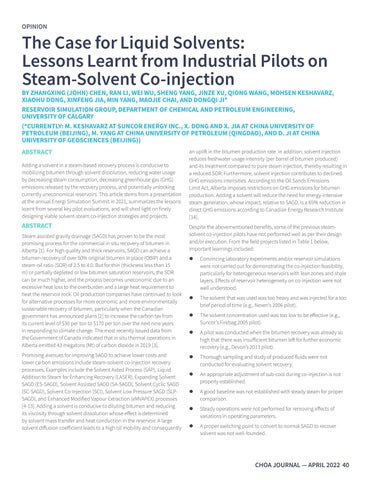OPINION
The Case for Liquid Solvents: Lessons Learnt from Industrial Pilots on Steam-Solvent Co-injection
BY ZHANGXING (JOHN) CHEN, RAN LI, WEI WU, SHENG YANG, JINZE XU, QIONG WANG, MOHSEN KESHAVARZ, XIAOHU DONG, XINFENG JIA, MIN YANG, MAOJIE CHAI, AND DONGQI JI* RESERVOIR SIMULATION GROUP, DEPARTMENT OF CHEMICAL AND PETROLEUM ENGINEERING, UNIVERSITY OF CALGARY (*CURRENTLY: M. KESHAVARZ AT SUNCOR ENERGY INC., X. DONG AND X. JIA AT CHINA UNIVERSITY OF PETROLEUM (BEIJING), M. YANG AT CHINA UNIVERSITY OF PETROLEUM (QINGDAO), AND D. JI AT CHINA UNIVERSITY OF GEOSCIENCES (BEIJING)) ABSTRACT Adding a solvent in a steam-based recovery process is conducive to mobilizing bitumen through solvent dissolution, reducing water usage by decreasing steam consumption, decreasing greenhouse gas (GHG) emissions released by the recovery process, and potentially unlocking currently uneconomical reservoirs. This article stems from a presentation at the annual Energi Simulation Summit in 2021, summarizes the lessons learnt from several key pilot evaluations, and will shed light on finely designing viable solvent-steam co-injection strategies and projects.
ABSTRACT Steam assisted gravity drainage (SAGD) has proven to be the most promising process for the commercial in situ recovery of bitumen in Alberta [1]. For high quality and thick reservoirs, SAGD can achieve a bitumen recovery of over 50% original bitumen in place (OBIP) and a steam-oil ratio (SOR) of 2.5 to 4.0. But for thin (thickness less than 15 m) or partially depleted or low bitumen saturation reservoirs, the SOR can be much higher, and the process becomes uneconomic due to an excessive heat loss to the overburden and a large heat requirement to heat the reservoir rock. Oil production companies have continued to look for alternative processes for more economic and more environmentally sustainable recovery of bitumen, particularly when the Canadian government has announced plans [2] to increase the carbon tax from its current level of $30 per ton to $170 per ton over the next nine years in responding to climate change. The most recently issued data from the Government of Canada indicated that in situ thermal operations in Alberta emitted 43 megatons (Mt) of carbon dioxide in 2019 [3]. Promising avenues for improving SAGD to achieve lower costs and lower carbon emissions include steam-solvent co-injection recovery processes. Examples include the Solvent Aided Process (SAP), Liquid Addition to Steam for Enhancing Recovery (LASER), Expanding Solvent SAGD (ES-SAGD), Solvent Assisted SAGD (SA-SAGD), Solvent Cyclic SAGD (SC-SAGD), Solvent Co-Injection (SCI), Solvent Low Pressure SAGD (SLPSAGD), and Enhanced Modified Vapour Extraction (eMVAPEX) processes [4-13]. Adding a solvent is conducive to diluting bitumen and reducing its viscosity through solvent dissolution whose effect is determined by solvent mass transfer and heat conduction in the reservoir. A large solvent diffusion coefficient leads to a high oil mobility and consequently
an uplift in the bitumen production rate. In addition, solvent injection reduces freshwater usage intensity (per barrel of bitumen produced) and its treatment compared to pure steam injection, thereby resulting in a reduced SOR. Furthermore, solvent injection contributes to declined GHG emissions intensities. According to the Oil Sands Emissions Limit Act, Alberta imposes restrictions on GHG emissions for bitumen production. Adding a solvent will reduce the need for energy-intensive steam generation, whose impact, relative to SAGD, is a 65% reduction in direct GHG emissions according to Canadian Energy Research Institute [14]. Despite the abovementioned benefits, some of the previous steamsolvent co-injection pilots have not performed well as per their design and/or execution. From the field projects listed in Table 1 below, important learnings included: z
Convincing laboratory experiments and/or reservoir simulations were not carried out for demonstrating the co-injection feasibility, particularly for heterogeneous reservoirs with lean zones and shale layers. Effects of reservoir heterogeneity on co-injection were not well understood.
z
The solvent that was used was too heavy and was injected for a too brief period of time (e.g., Nexen’s 2006 pilot).
z
The solvent concentration used was too low to be effective (e.g., Suncor’s Firebag 2005 pilot).
z
A pilot was conducted when the bitumen recovery was already so high that there was insufficient bitumen left for further economic recovery (e.g., Devon’s 2013 pilot).
z
Thorough sampling and study of produced fluids were not conducted for evaluating solvent recovery.
z
An appropriate adjustment of sub-cool during co-injection is not properly established.
z
A good baseline was not established with steady steam for proper comparison.
z
Steady operations were not performed for removing effects of variations in operating parameters.
z
A proper switching point to convert to normal SAGD to recover solvent was not well-founded.
CHOA JOURNAL — April 2022 40
